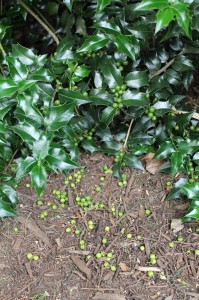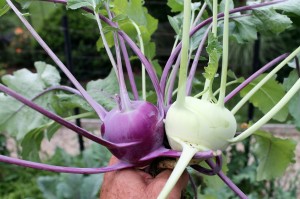Mystery Plant
June 25th, 2013
I was out inspecting the botanical troops the other day (my favorite summer pasttime) when one particular bloom caught my eye.
The flower was a soft but true blue in color and rounded in shape – about the size of a baseball.
It was sitting dead center in the middle of a rosette of variegated foliage in a shaded spot of my front side yard, under a cherry tree.
Let’s see how good you are. Can anybody identify it?
A photo is at right. Email me at george@georgeweigel.net if you know what it is.
I may have stumbled onto something new, and I’ve got the perfect name for it. I’ll let you know as soon as somebody guesses.
Lots of other interesting stuff is going on at this time of year.
Something that two people asked about in the last week is why the little, immature berries are dropping off the dark-leafed elderberry bushes and the evergreen hollies – in particular, ‘Dragon Lady.’
I have both ‘Black Lace’ elderberry and ‘Dragon Lady,’ and the same thing happens every spring to mine.
The most likely explanation is a pollination issue. Young fruits (technically, ovaries) form on these plants in spring, but if they’re not pollinated, the fruits drop.
Elderberries are somewhat self-pollinating, so you may get some fruits with just one. But the best fruiting will happen when a second and different variety of the same species is planted nearby.
‘Dragon Lady’ is a female holly and needs a male nearby to pollinate her. If you’re getting no fruits, a suitable male that blooms at the same time is needed. If you’re getting some mature fruits but most green berries are dropping off, it’s more likely that the pollination is poor or incomplete.
I also suspect ‘Dragon Lady’ might just genetically shed a portion of its fruits, somewhat like the natural thinning of fruit trees (i.e. the so-called “June drop” of apples).
In both cases, dropping fruit most likely is not a sign that something’s wrong with the plants.
My hydrangeas aren’t having any difficulty in the bloom department this year. I’m seeing one of the best and heaviest hydrangea blooms ever in my yard.
Particularly eye-grabbing are my two ‘Endless Summers,’ which are blooming in multiple shades of blue, pink and purple like some kind of explosion at the cotton-candy factory.
The mixed colors tells me my soil is probably close to neutral in acidity. In alkaline soil, hydrangeas lean pink. In acidy soils, they turn blue. Somewhere in the middle (usually a pH of 5 to 6), they bloom a murky blend or put out a mix of colors.
I kinda like the mix. But if you’re a one-way-or-the-other person, add lime to go pink or sulfur to go blue.
Another eye-grabber that hardly anyone knows or plants is Japanese hydrangea vine ‘Moonlight.’
York County’s Barry Yinger discovered this one in Japan, and it’s a beautiful shade-preferring woody climber that puts out lacecap-hydrangea flowers of pure white in June and July. The leaves are heart-shaped and have a silvery sheen, which makes the plant a beauty even out of bloom.
I have one growing up a brick wall around my northeast house corner to hide a spout and cable wires. It’s fanned out nicely to give eye-level color to an otherwise bare area.
The only thing you have to watch is that ‘Moonlight’ clings and grows fairly fast. So if you don’t want it sucking onto a wall, grow it up a pergola or trellis. And snip it every so often to control the spread and make sure no arms grab on where you don’t want.
And in the vegetable garden, another little-used plant that I’m harvesting now is kohlrabi.
This cabbage-family plant looks like something from another planet with its stems randomly poking out and up from the handball-sized edible orbs that grow just above the ground.
I especially like the purple ones. They’re beautiful in the garden but taste pretty much like the “normal” creamy ones. I’m growing both this year from Renee’s Garden Seeds’ ‘Crispy Colors Duo.’
These have a mild cabbage flavor and are crispy in texture – excellent when sliced and eaten raw with a favorite dip.
Kohlrabi is also easy to grow and can be direct-seeded into the garden in early spring.











